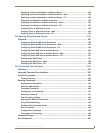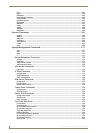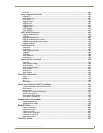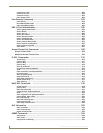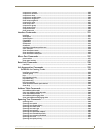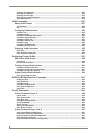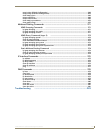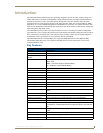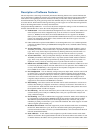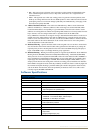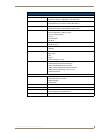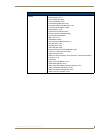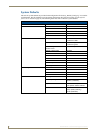
Introduction
1
NXA-ENET24 - Software Management Guide
Introduction
The NXA-ENET24 Fast Ethernet switch is specifically designed to protect the video streams coming from
AMX’s MAX units to the Audio Video Modules (AVM). Standard switches will reduce bandwidth from all
applications when there is heavy data traffic passing through the switch. For streaming audio and video
applications this will cause skipping and jitter in the audio and video feeds. This is unacceptable for AMX’s
applications. As a result, AMX has designed the NXA-ENET24 to protect the A/V streams when heavy data
traffic occurs. Bandwidth is reduced from other applications such as file transfer, e-mail and web surfing only
when during heavy data traffic events.
The NXA-ENET24 also provides a full range of features for Layer 2 switching. It includes a management
agent that allows you to configure the features listed in this manual. The default configuration can be used for
most of the features provided by this switch. However, there are many options that you should configure to
maximize the switch’s performance for your particular network environment.
The NXA-ENET24 PoE’s 24 10/100 Mbps ports support the IEEE 802.3af Power-over-Ethernet (PoE)
standard that enables DC power to be supplied to attached devices over the unused pairs of wires in the
connecting Ethernet cable.
Key Features
Key Features
Feature Description
Power over Ethernet Powers attached devices using IEEE 802.3af Power over Ethernet (PoE)
Configuration Backup and
Restore
Backup to TFTP server
Authentication Console, Telnet – User name / password, RADIUS, TACACS+
Telnet – SSH
SNMP – Community strings, IP address filtering
Port – IEEE 802.1x, MAC address filtering
Access Control Lists Supports up to 32 IP or MAC ACLs
Access Control Lists Supports up to 32 IP or MAC ACLs
DHCP Client, Relay Supported
DNS Server Supported
Port Configuration Speed, duplex mode and flow control
Rate Limiting Input and output rate limiting per port
Port Mirroring One or more ports mirrored to single analysis port
Port Trunking Supports port trunking using either static or dynamic trunking (LACP)
Broadcast Storm Control Supported
Static Address Up to 8K MAC addresses in the forwarding table, 128 static entries in ARP
cache
IEEE 802.1D Bridge Supports dynamic data switching and address learning
Store-and-Forward Switching Supported to ensure wire-speed switching while eliminating bad frames
Spanning Tree Protocol Supports standard STP and Rapid Spanning Tree Protocol (RSTP)
Virtual LANs Up to 255 using IEEE 802.1Q, port-based, or private VLANs
Traffic Prioritization Default port priority, traffic class map, queue scheduling,
IP Precedence, or Differentiated Services Code Point (DSCP), and TCP/UDP
Port
IP Routing Routing Information Protocol (RIP), Open Shortest Path First (OSPF), static
routes
ARP Static and dynamic address configuration, proxy ARP
Multicast Filtering Supports IGMP snooping and query for Layer 2, and IGMP for Layer 3
Multicast Routing Supports DVMRP and PIM-DM



